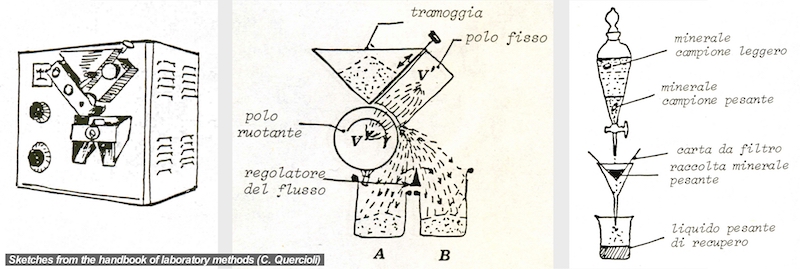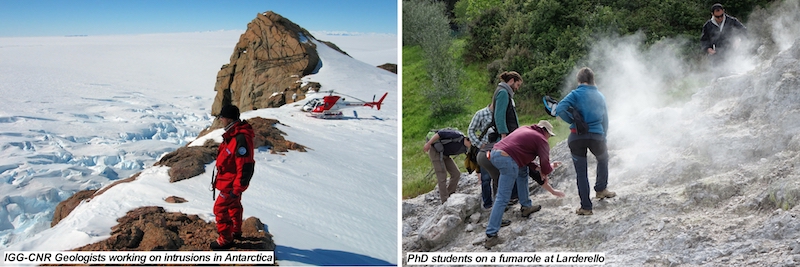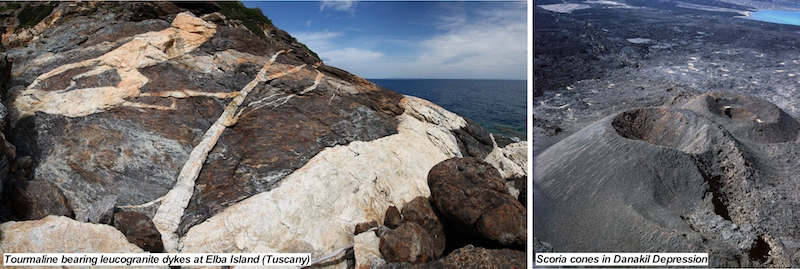Pisa Territorial Unit
METHODS AND APPLICATIONS
Significant resources are expended acquiring geochemical, isotopic and geochronological data. Money, time and effort are invested from the earliest stage of identifying a need to characterize a geological sample, followed by planning and sample collection, mineral separation processes, data acquisition, data processing, report writing and data management. The researchers and end-users need assurance that the best sample possible has been obtained and analysed. The chain of quality control required for good isotopic analysis begins with field sampling and continues with detailed attention to mineral separation and final sample preparation.

The first steps of the operational chain in the Rock/Mineral Preparation Laboratory (splitting, cutting, crushing, milling and sieving) represent very rough activities but it is from them that depends on the quality of the final result. Cutting and polishing of large rock slabs allow a detailed textural observation and selection of the best volumes for preparation of thin sections, mineral separates and powders.
The mineral separates are then created by exploiting the physical properties of minerals including density, magnetic susceptibility, hydrodynamic properties, color, crystal form, etc. Minerals or groundmass that have been sorted into particular size ranges by sieving may be isolated from other phases by exploiting their density contrasts and settling the particles in water (shaking table) and/or in heavy liquid (non-toxic Na-polytungstate). Heavy and light fractions can be further separated on the basis of contrasts in magnetic susceptibility. This is done using first a strong permanent magnet and then a Frantz magnetic separator. Once a purified concentrate of the mineral of interest is available using the methods outlined above, individual crystals are inspected under binocular microscopes. At this stage any crystals or groundmass grains that exhibit alteration, or adhering glass or other mineral phases, are excluded.
PROJECTS AND SCIENTIFIC INTERESTS
Most of the “hard-rock” research projects developed at IGG-CNR start from (rock/mineral preparation) and end into (storage) this laboratory. Until few years ago it was one of the few well-equipped laboratories in Italy with a highly qualified expertise on mineral separation. Most of the rocks collected in Antarctica during the ca. 30 Italian Expeditions have been prepared here, although the final storage destination of rock samples is at the National Antarctic Museum in Siena. Similarly, most of the drill cores collected in deep geothermal exploratory wells in Tuscany (granites, metamorphic and sedimentary rocks) have been prepared in this laboratory. Some cores are currently in the lab in the frame of the H2020 European Project “DESCRAMBLE”.

Mineral separates were here produced for the first Rb-Sr, K-Ar and fission-tracks geochronological determinations performed in the world during the 1960’s-1970’s, and many samples are nowadays processed for the research activity of the IGG-CNR Ar-Ar and fission tracks laboratories (respectively in Pisa and Florence). During the last 50 years, magmatic rocks from almost all the active volcanoes and main intrusive belts in the World were brought to the Lab by Italian and International researchers for preparing powders and mineral separates for geochemical, isotopic and geochronological studies.

The Preparation Laboratory is actively used also by groups working on environmental and paleo-climate projects as well as on volcanology and sedimentology projects. The laboratory is open to collaboration with national and international research groups providing training for young PhD and Post-Doc students, following specific agreements.
SELECTED PUBLICATIONS
- BALESTRIERI M.L, BONINI M., CORTI G., SANI F., PHILIPPON M. (2016) A refinement of the chronology of rift-related faulting in the Broadly Rifted Zone, southern Ethiopia, through apatite fission track analysis. Tectonophysics, 671, 42-55.
- DI VINCENZO G., GRANDE A., PROSSER G., CAVAZZA W., DECELLES P. (2016) 40Ar-39Ar laser dating of ductile shear zones from central Corsica (France): Evidence of Alpine (middle to late Eocene) syn-burial shearing in Variscan granitoids. Lithos, 262, 369 - 383.
- DI VINCENZO G., GRANDE A., ROSSETTI F. (2014) Paleozoic siliciclastic rocks from northern Victoria Land (Antarctica): Provenance, timing of deformation, and implications for the Antarctica-Australia connection. GSA Bulletin, 126, n. 11/12, 1416-1438.
- FARINA F., DINI A., ROCCHI S. AND STEVENS G. (2014) Extreme mineral-scale Sr isotope heterogeneity in granites by disequilibrium melting of the crust. Earth and Planetary Science Letters, 399, 103–115.
- LAURENZI M., BRASCHI E., CASALINI M., CONTICELLI S. (2015) New 40Ar-39Ar dating and revision of the geochronology of the Monte Amiata Volcano, Central Italy. Bollettino Società Geologica Italiana, Italian Journal of Geosciences, 134, 255 - 265.
- VEZZONI S., DINI A. AND ROCCHI S. (2016) Reverse telescoping in a distal skarn system (Campiglia Marittima, Italy). Ore Geology Review, 77, 176-193.
- QUERCIOLI C. (1988) Metodi per la separazione e purificazione dei minerali utilizzati in geocronologia e geochimica. Ed. Azienda Grafica Tecnostampa, Pisa, 68 pp.
- CHISHOLM E.K., SIRCOMBE K. and DI BUGNARA D. (2014) Handbook of Geochronology Mineral Separation Laboratory Techniques. Record 2014/46. Geoscience Australia, Canberra, 45 pp. dx.doi.org/10.11636/Record.2014.046